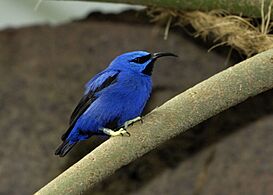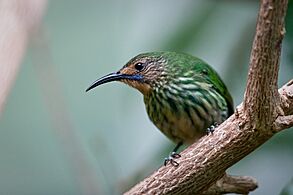Purple honeycreeper facts for kids
Quick facts for kids Purple honeycreeper |
|
|---|---|
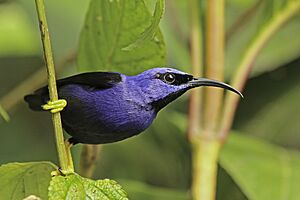 |
|
| Adult male C. c. longirostris, Trinidad | |
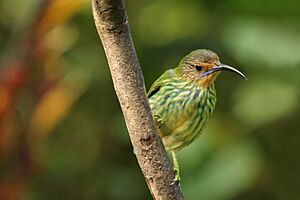 |
|
| Adult female C. c. longirostris, Trinidad | |
| Conservation status | |
| Scientific classification | |
| Genus: |
Cyanerpes
|
| Species: |
caeruleus
|
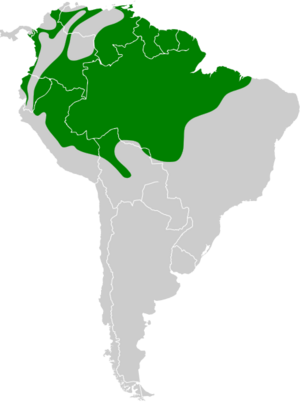 |
|
| Synonyms | |
|
Certhia caerulea Linnaeus, 1758 |
|
The purple honeycreeper (Cyanerpes caeruleus) is a small, colorful bird. It lives in the tropical parts of the New World, which means places like Central and South America. You can find these birds from Colombia and Venezuela all the way south to Brazil. They also live on the island of Trinidad. Sometimes, you might even spot them on Tobago, though they might have been brought there by people. This bird is part of the tanager family, called Thraupidae.
Contents
Discover the Purple Honeycreeper
What Does a Purple Honeycreeper Look Like?
The purple honeycreeper is a small bird, about 4.5 inches (11.5 cm) long. It weighs around 0.42 ounces (12 grams), which is about as much as a few paper clips! It has a long, black, curved beak.
Male purple honeycreepers are mostly bright purple. They have black wings, a black tail, and a black belly. Their legs are a bright yellow color.
Female and young honeycreepers look different. They have green feathers on their backs and heads. Their undersides are yellowish-buff with green streaks. They also have a cinnamon-colored throat and a blue stripe that looks like a mustache. When they call, you might hear a thin, high-pitched sound like zree. The honeycreepers living on Trinidad have a longer beak than those on the mainland.
Where Do Purple Honeycreepers Live?
These birds live in northern South America, including the large Amazon Basin and the Guianas. You can also find them along the coast west of the Andes mountains, even in parts of southern Panama. Their home stretches south to the very western edge of the Pantanal, a huge wetland area.
Purple honeycreepers usually live in lowlands, up to about 3,300 feet (1,000 meters) above sea level. But sometimes, they can be found much higher, even up to 7,500 feet (2,300 meters) above sea level!
These birds prefer to live in the very tops of forest trees, called the forest canopy. They also like to live in farms that grow cocoa (for chocolate) and citrus fruits. In higher places, they live in rainforests that are often full of epiphytes (plants that grow on other plants) and mosses. They can even be found in tiny "elfin forests" or open grasslands called páramo.
How Do Purple Honeycreepers Live?
Purple honeycreepers are often seen in small groups. They are quite brave and curious birds! If they hear the call of a ferruginous pygmy owl, which is a predator, they will often come out of hiding to find and bother it. This is called mobbing.
Eating Habits
These birds eat many different things. They love nectar from flowers, especially from plants like bromeliads. Their curved beak is perfect for reaching deep into these flowers! They also eat berries and seeds from plants like Trema and Clusia. Sweet fruits like bananas and papayas are also on their menu. Besides plants, they eat insects. They usually find all their food high up in the forest canopy.
Family Life and Reproduction
When it's time to build a nest, the female purple honeycreeper makes a small cup-shaped nest in a tree. She lays two white eggs that have brown spots. She then sits on the eggs to keep them warm until they hatch.
Different Kinds of Purple Honeycreepers
Scientists have studied the purple honeycreeper and found that there are five different types, called subspecies. These subspecies are slightly different from each other, often based on where they live.
- C. c. chocoanus – Found from eastern Panama to western Ecuador.
- C. c. caeruleus – Lives in central Colombia and Venezuela, through the Guianas, and north-central Brazil.
- C. c. hellmayri – Found in the Potaro Highlands of Guyana.
- C. c. longirostris – This type lives on the island of Trinidad.
- C. c. microrhynchus – Found in western and central Amazonia.
Scientists like Carl Linnaeus first described this bird in 1758. He gave it the scientific name Certhia carrulea. Later, it was moved to a different group, or genus, called Cyanerpes. The word caeruleus is Latin and means "dark blue," which perfectly describes the male bird!
Images for kids
-
Young male C. c. longirostris in Trinidad
-
Adult male at Vienna Zoo, Austria. Notice how captive birds often have pale legs.
-
Female at Diergaarde Blijdorp in the Netherlands




